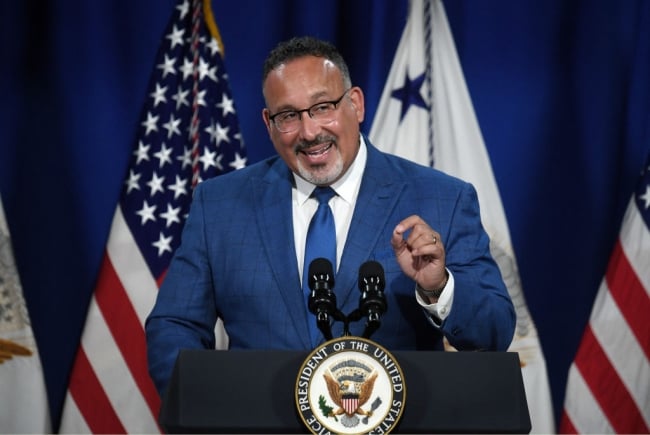You have /5 articles left.
Sign up for a free account or log in.

Education secretary Miguel Cardona asked governors to consider the impact of the FAFSA delays on their state grant programs.
Olivier Douliery/AFP via Getty Images
Secretary of Education Miguel Cardona sent a letter to state governors on Monday urging them to prepare for the consequences of FAFSA delays by pushing back state financial aid application deadlines and adjusting expectations for state grant eligibility.
Under the new FAFSA, changes to the student aid eligibility formula—the Student Aid Index, formerly the Estimated Family Contribution— will also have a major impact on state aid, which usually covers gaps in unmet financial need that remain after federal aid is applied.
Because of that, Cardona reminded governors to “ensure your state has budgeted for state grant aid increases that may be needed based on changes to eligibility calculations.”
“These changes will likely impact the budgeting, design, and distribution of grant programs in your state,” he wrote.
The department began sending processed student aid forms to colleges and state grant agencies earlier this month, two months later than originally expected. Last week, the department announced that processing the forms would take longer than expected, in part due to an overlooked calculation error, and that students would not be able to make corrections to their forms until April.
“We know that this may impact requirements in your state, particularly if your state requires FAFSA completion for high school graduation,” Cardona wrote to governors.
Because of that delay, Cardona recommended that states with priority financial aid deadlines before mid-May extend them so students don’t miss out after a chaotic cycle. Some states have already done so; California announced Monday that it would push its deadline back from April 2 to May 2.
Cardona also encouraged state officials to consider the impact of the new Student Aid Index formula on state grant amounts and student eligibility. Those effects will vary depending on whether the state program is first-dollar—meaning all students who are eligible are entitled to it—or last-dollar, meaning grants are doled out on a first-come, first-served basis.
In states with first-dollar programs, students will likely be entitled to more state aid regardless of how much their Pell amount increases. In states with last-dollar programs, which are much more common, students will be eligible for more state aid but, due to the expansion of Pell eligibility more broadly, the programs may be exhausted of funds before many students have a chance to apply—or even know they qualify. Cardona recommended they set aside money to ensure these students aren’t left out.
“It’s critical to ensure your funds do not deplete early so that all students who qualify for state grant aid are able to access funds,” he wrote.
Cardona also asked governors to urge institutions in their state to push back the standard May 1 student commitment deadlines, which some colleges have done, though not the majority.









